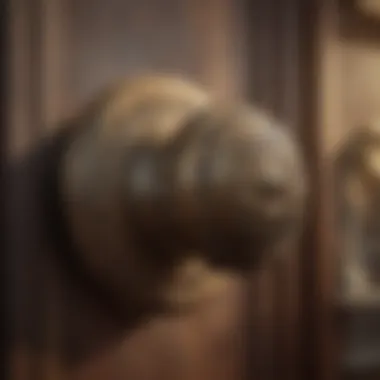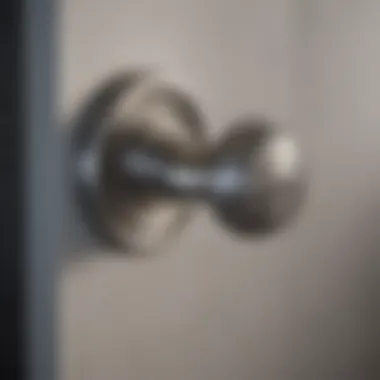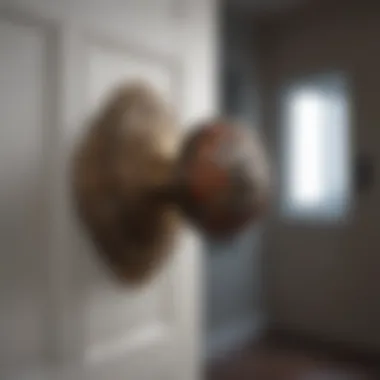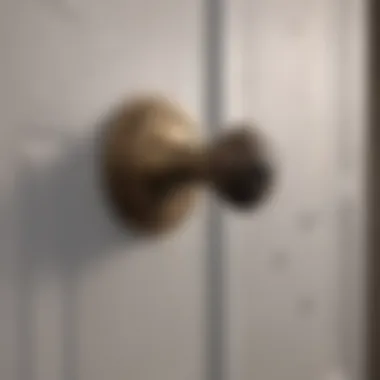Exploring Door Knobs and Handles: History and Design


Intro
Door knobs and handles, though seemingly mundane fixtures, are pivotal elements in any home. They serve not just a practical function but also play a significant role in the aesthetic appeal of spaces. Understanding their varied facets can enrich the realm of home improvement, contributing to both style and security.
When you walk through a door, your hand instinctively reaches for the knob or handle. Yet, few stop to consider the history, evolution, and choices available in this often-overlooked aspect of home design. From classic brass knobs to sleek modern handles, the options available today are myriad, inviting homeowners to think critically about what fits their style. Each choice carries implications for functionality, security, and maintenance.
The importance of this topic cannot be understated. Quality door knobs and handles offer more than just utility; they also enhance the overall ambiance of homes. An elegant handle can elevate the look of a room, while a robust knob ensures safety. In an age where interior design is as personal as it gets, every detail counts.
By exploring these intriguing elements, homeowners can more effectively navigate the choices they face, whether they’re renovating a single room or updating an entire house. In the sections that follow, we will delve into the common challenges faced by homeowners, recommended products suited for various needs, and step-by-step guides that will empower individuals to make informed decisions.
Historical Overview of Door Knobs and Handles
Understanding the historical journey of door knobs and handles gives us insight not just into their evolution, but also into the lives and cultures of those who used them throughout history. These seemingly simple objects have a significant role in architecture and security, representing a blend of form, functionality, and societal progress. As we delve into this historical overview, we will uncover how these tools have adapted over time, reflecting changes in design preferences, advances in technology, and shifts in societal needs.
The Origins of Door Hardware
The concept of a door hardware dates back to ancient times when humans first required privacy and security in their homes. Evidence from archaeology suggests that the first forms of door hardware originated as rudimentary locks and bolts forged from bronze and wood. Ancient Egyptians, for example, used wooden doors secured with wooden beams, often adorned with carvings that reflected their culture and status.
As time marched on, cultures around the globe began to innovate their door hardware. The Romans furthered this craft by introducing metal door hinges and more advanced locking mechanisms. This marked a substantial leap in security. In places like the Indus Valley, archeologists have unearthed well-constructed doors with intricate locking systems, indicating a thriving community's focus on safety and privacy.
As we reflect on the origins, it's pivotal to note that these early innovations were practical, serving immediate needs. Door knobs and handles as we know them today began making an appearance in the 18th century, coinciding with advances in decorative arts and ironwork. This period saw a rise in the use of brass, turning these functional items into decorative pieces, thus weaving them into the aesthetic fabrics of homes.
Evolution Through the Ages
The evolution of door knobs and handles is a fascinating reflection of both technological advancements and shifting social dynamics. In the 19th century, with the Industrial Revolution kicking into high gear, door hardware manufacturing transitioned from artisan craftsmanship to factory production. This change not only made door knobs and handles more accessible but also led to a significant variety in designs and materials.
- Victorian Era: During this time, ornate designs flourished, with intricate motifs that conveyed both elegance and status. Patterns were influenced by Gothic architecture and often featured brass as a rich metallic option, wonderfully enhancing their surroundings.
- Modern Era: Fast forward to the 20th century, where functionality often took precedence over form. Handles became more streamlined, focusing on minimalism and ease of use rather than decorative aspects. The introduction of new materials like stainless steel and plastic also played a key role, making door hardware easier to produce and maintain.
"As society progresses, so too does the art of crafting everyday tools, transforming mere objects into symbols of both heritage and innovation."
The close of the 20th century and the dawn of the 21st century witnessed the rise of smart technologies, allowing door knobs and handles to take on functionalities that were previously unimaginable. From keyless entries to biometric systems, today's door hardware not only fulfills its traditional roles but integrates seamlessly with modern lifestyles, bringing convenience alongside security.
Types of Door Knobs
Understanding the various types of door knobs is crucial as these fixtures play not just a functional role but also contribute significantly to the overall design and usability of a space. Each type serves a specific purpose and is designed with unique characteristics, making it essential for homeowners to select a type that aligns with their needs and lifestyle preferences. This section aims to break down the different categories of door knobs, each with its individual advantages and considerations.
Standard Knobs
Standard door knobs are the most common type found in homes. These knobs are typically round and make use of a simple turning mechanism to operate the door latch. They are quite versatile and can fit on both interior and exterior doors. When choosing standard knobs, homeowners must consider the right materials and designs that complement their home aesthetic.
- Variety of Designs: From classic polished brass to modern matte finishes, standard knobs come in various styles.
- Functionality: They provide ease of use, making them suitable for entry doors where quick access is needed.
- Cost-Effectiveness: Generally more affordable than specialized types, they allow for bulk purchasing without breaking the bank.
However, it is also important to ensure that the diameter fits comfortably in your hand for a good grip, particularly for those with mobility concerns.
Privacy Knobs
Privacy knobs are particularly designed for spaces where a higher level of confidentiality is desired, such as bathrooms and bedrooms. Unlike standard knobs, privacy models can be locked from the inside, providing peace of mind when needed.
- Locking Mechanism: These knobs usually feature a push-button or twist-lock mechanism that is straightforward to operate.
- Safety: In situations where many people live together, such as families or roommates, privacy knobs prevent unauthorized access, protecting personal space.
- Aesthetic Choices: They come in various styles and finishes, allowing homeowners to match them with the rest of their door hardware.
Despite their advantages, it’s vital to note that privacy knobs don’t always offer the same level of security as keyed locks, so they might not be suitable for front doors or areas needing enhanced security.
Dummy Knobs
Dummy knobs, unlike their functional counterparts, do not serve as operating handles. They are simply decorative knobs used primarily on double doors or non-functional surfaces such as cabinets.
- Decoration: Dummy knobs bring a touch of elegance and sophistication to spaces, allowing homeowners to enhance the design without needing functionality.
- Ease of Installation: Since they don’t require a locking mechanism, they can be easily installed without complex hardware.
It's worth pointing out that, while they might not serve a functional purpose, dummy knobs can tie a room's design together and bring about a sense of completeness. They can also be beneficial in cases where there's a need for symmetry, like in a set of French doors.
The right choice of door knob can greatly affect your home's aesthetic. Whether you're after functionality, privacy, or purely decorative appeal, consider the type that best suits your lifestyle.
Varieties of Door Handles
When it comes to the aesthetic and functional aspects of door fixtures, the varieties of door handles play a pivotal role. Each type brings its own set of functionalities and style, addressing different needs and preferences of homeowners. In every home, these door handles serve not only as entry points but also as expressions of personal style and practicality. They enhance the user experience by providing ease of access and complementing the overall design vibe. This section covers the three main types of door handles: lever handles, pull handles, and push/pull configurations.
Lever Handles
Lever handles have gained a strong footing in many modern households due to their elegant design and functional advantages. Unlike traditional knobs that require a twisting action, lever handles offer a simple push or pull motion. This feature can be particularly helpful in a busy household where users might have their hands full. The ease of operation makes them a favorable choice for persons with mobility issues or for young children. Furthermore, lever handles come in various styles, from minimalist modern designs to more ornate traditional looks, allowing homeowners to find the perfect fit for their decor.
Common materials used for lever handles include brass, stainless steel, and various alloys, all contributing durability. It's also common to see lever handles fitted with locking mechanisms for added security, especially in bedrooms or bathrooms.
Pull Handles
Pull handles are often found on larger doors, like those leading to patios or commercial spaces. They come in various sizes and designs, making them versatile for both interior and exterior uses. The user simply grasps the handle and pulls the door towards them, allowing for a straightforward operation.
Available in a range of materials—from heavy-duty metals to elegant wood—pull handles can make a significant style statement. For instance, a solid wood pull handle can add warmth and character to a rustic setting, while a polished metal version might fit seamlessly in a contemporary design.
The installation of pull handles can require more consideration compared to knobs or levers, especially for heavy doors, as they must withstand repeated use without compromising the integrity of the door itself.
Push/Pull Configurations


Push/pull configurations present a hybrid approach that marries functionality with simplicity. Typically seen in commercial settings, they have started to gain traction in residential designs as well. This type of handle requires the user to either push or pull the door using a graspable surface—making them practical for high-traffic areas.
Because of their universal appeal, push/pull handles are designed to be intuitive. They help facilitate movement, especially in situations where quick access is needed. Consideration for safety is also essential; many designs include anti-slip features to prevent accidents, particularly in homes where children wander in and out frequently.
In summary, the choice of door handles should align with personal preference, considering not only the aesthetic properties but also the functional benefits.
"The right door handle not only provides ease of access but also speaks volumes about the overall design ethos of the home."
When making a decision about door handles, take into account the specific needs of your household, the style of your home, and, importantly, the comfort of those who will use them daily.
Material Choices for Door Knobs and Handles
When it comes to door knobs and handles, material selection is paramount. The choice of materials not only affects durability and maintenance but also influences the aesthetics and overall function of these fixtures. Different materials carry unique properties that can enhance or detract from a door's character, usability, and security. For homeowners looking to maintain or upgrade fixtures, understanding these options can spark creativity and practicality in design.
Metal Options
Brass
Brass has been a go-to choice for many door knobs and handles over the years. Its longstanding popularity comes from its excellent resistance to corrosion and tarnish, making it not just a pretty face but a robust worker in day-to-day use. One of the key characteristics of brass is its rich, golden hue, which adds warmth to any space—think classic elegance without trying too hard.
Brass has a unique feature in that it can naturally develop a patina over time, which many homeowners appreciate for the character it can lend to a home. However, this can be a double-edged sword; some might find the upkeep daunting since polishing might be needed to maintain the bright look. In any case, brass remains a beneficial choice for those wanting style mixed with durability.
Stainless Steel
Stainless steel takes the spotlight as an outstanding option for modern interiors. Noted for its sleek, shiny finish, it’s a popular pick given its resilience against rust and stains. The key characteristic of stainless steel is scratch resistance, making it ideal for high-traffic areas where wear and tear are concerns. For those looking for a contemporary edge, it fits the bill perfectly.
What sets stainless steel apart is its ability to blend seamlessly into various decor styles, from minimalist to industrial. However, it’s worth noting that while maintenance is generally low, fingerprints can appear easily on the surface, which may necessitate occasional cleaning. This option showcases a beneficial blend of form and function that is hard to overlook.
Bronze
Bronze offers a unique twist, infusing a rustic vibe into home design. Its often warm brown tones can complement a myriad of styles, from traditional to Mediterranean. The heavy nature of bronze also adds a sense of solidity—akin to an ancient fortress door. Its resistance to corrosion makes it a sound choice for both indoor and outdoor environments.
One unique feature of bronze is that, like brass, it can oxidize and develop a beautiful patina over time, leading to a stylish look that many people desire. This characteristic can also deter theft or mischief, as worn or aged fixtures may appear less inviting to outsiders. Still, potential buyers should consider the autumnal hue as not everyone's cup of tea, especially in bright, modern settings.
Non-Metal Alternatives
Plastic
When considering plastic for door knobs and handles, it's often dismissed as lower-quality. However, modern plastics are surprisingly durable and can withstand the elements better than traditional materials. A major benefit of plastic is the almost infinite color options available, allowing homeowners to express personal style with ease.
The unique aspect of plastic is its lightness. Many prefer it for childproof homes where a lighter touch helps in design and safety. On the downside, while durable, plastics can sometimes get a reputation for looking cheap, a trade-off for their affordability. Overall, those on a budget may find a beneficial option here.
Wood
Wood offers an organic touch that warmth and character set apart. The intricate patterns and colors can make them standouts in a home. People often opt for wooden handles in environments designed to create a cozy, inviting atmosphere—think log cabins or rustic kitchens.
A unique feature of wood is its ability to provide varying textures that can contribute to tactile experiences throughout the home. While naturally beautiful, wood does require regular maintenance to avoid warping from moisture or fading from sunlight. Hence, it's a noble choice, yet one that does come with its own set of responsibilities.
Composite Materials
Lastly, composite materials bring innovative solutions into the game. These can include blends of wood particles, plastics, and resins, offering a unique aesthetic while being designed to withstand wear and tear. One of the most notable aspects of composite materials is their versatility—they can mimic the look of wood while providing greater durability.
Typically, composites won’t warp or crack like wood, nor will they rust like metals, making them exceptionally low-maintenance. While they may not have the same character as solid wood or brass, they carve out a niche for those seeking durability without sacrificing style. Thus, composite materials stand as a compelling choice for modern needs.
"Choosing the right material for door knobs and handles isn't just about looks; it's about finding the right fit for your home’s lifestyle and functionality."
With each of these materials coming with its pros and cons, understanding their properties can empower homeowners to make informed design decisions that harmonize with their home's essence.
Functional Aspects of Door Knobs and Handles
When contemplating door knobs and handles, functionality is at the heart of their essence. The practicality of these fixtures extends beyond mere aesthetics. Understanding their functional aspects can dramatically influence your choices, ensuring safety and convenience in daily life.
Mechanisms of Operation
How Knobs Function
Knobs are a classic choice, often favored for their simple design and ease of use. Most standard knobs operate with a rotational mechanism. When you turn the knob, it engages a latch, allowing the door to open or close seamlessly. This straightforward design makes knobs accessible for people of all ages.
One of the key characteristics of knobs is their versatility. They come in various styles and finishes, which means you can find a knob that perfectly suits your home’s aesthetic. However, they have a unique feature worth noting: the required grip strength. For some individuals, particularly those with limited hand strength, turning a knob can be less ideal compared to lever alternatives.
Advantages:
- Aesthetic Variety - Available in numerous designs and materials.
- Ease of Installation - Generally straightforward to install, making them convenient for DIY enthusiasts.
Disadvantages:
- Grip Requirement - May not be the best option for all users.
Lever Mechanisms
Lever handles present a modern alternative to knobs. They function by pushing down on the lever arm, which engages either a latch or a lock. The ease of operation is a standout characteristic, especially for individuals with mobility challenges. Less hand strength is needed to operate a lever compared to turning a knob.


In busy households or commercial spaces, levers quickly become a preferred choice. This is especially true in areas that experience high foot traffic, as they provide a quick means of access without the need for twisting.
Advantages:
- Enhanced Accessibility - Ideal for users of all ages and abilities.
- Quick Access - Facilitates easier passage in bustling environments.
Disadvantages:
- Space Requirement - Levers can require more horizontal space than knobs.
Security Features
Security is a primary consideration in selecting door hardware. Both knobs and handles serve distinct roles in enhancing your home’s security.
Locking Mechanisms
Locking mechanisms are crucial for securing doors. A well-designed locking mechanism provides peace of mind, knowing that your space is protected. Common types include deadbolts and knob locks. A deadbolt, typically more robust, reinforces security and is often found in external doors. The key characteristic of effective locking mechanisms is their resistance to tampering.
When selecting locks, consider their ratings, as some have been tested for durability and resistance to forced entry. Those that meet or exceed standards like ANSI/BHMA can be particularly reassuring.
Advantages:
- Enhanced Security - Reduces the risk of unauthorized access.
- Robust Variability - Different levels of security available in the market.
Disadvantages:
- Complex Installation - Some may require professional installation to ensure effectiveness.
Anti-theft Designs
Thinking about additional security, anti-theft designs provide an extra layer of protection. Features like lateral key slots or reinforced locking latches fall under this category. These fixtures help deter break-ins by making it harder for intruders to manipulate locks.
The critical aspect of these designs is their incorporation of technology. Many modern locks now come with smart features, which allow homeowners to monitor access through their devices. While it often adds complexity, it enhances control over who enters the home.
Advantages:
- Advanced Features - Some can integrate with smart home systems.
- Real-time Monitoring - Provides alerts if unauthorized access occurs.
Disadvantages:
- Cost - Often more expensive than standard locking options.
"Choosing the right door hardware isn't just about looks. It's about creating a safe, functional space that meets your needs."
In summary, the functional aspects of door knobs and handles play a vital role in their performance, safety, and usability. By analyzing mechanisms and security features, homeowners can make informed decisions that enhance both the convenience and security of their living spaces.
Installation Considerations
When it comes to door knobs and handles, effective installation can make a world of difference. Properly installed hardware not only enhances the functionality of a door but also contributes to the overall aesthetic of your space. Taking the time to get this right pays off in long-term durability and ease of use. Neglecting installation aspects might lead to frustrating experiences, such as doors that don’t latch properly or handles that wiggle.
Measuring and Alignment
A critical part of installation begins with accurate measuring and alignment. Missing the mark here can lead to crooked knobs or handles, and let’s face it, that can be quite an eyesore. To achieve the best results, it’s wise to use a tape measure or a level to determine exactly where the hardware will be placed. A common guideline is to install door knobs at a height of around 36 to 48 inches from the floor, depending on the average height of your family members.
Use a pencil to mark the spot before drilling. This gives you a chance to step back and ensure that everything looks straight. It might seem trivial, but spending some extra time on this step can save you from headaches down the line.
Tools Required for Installation
Gathering the right tools before starting can save you time and frustration. Generally, you would need:
- Screwdriver – Either a flathead or Phillips, depending on the screws of your door hardware.
- Drill – For making holes if new ones are required.
- Tape Measure – To ensure accuracy in your dimensions.
- Level – For confirming that your knobs and handles are hung straight.
- Pencil – For marking locations before you drill or screw in.
Having these tools handy helps streamline the whole process and avoids those annoying mid-project trips to find that one missing tool. Trust me; it's worth it!
Step-by-Step Installation Process
Now, let’s walk through a general installation process. This will vary a bit depending on the type of knob or handle you’re installing, but the following steps are fairly universal.
- Gather Your Tools and Materials: Before anything else, make sure you have everything ready, as mentioned previously.
- Measure and Mark Placement: Use the tape measure and pencil to mark where the knob or handle should go.
- Drill Holes: If replacing an old knob or handle, you might not need to drill again. If installing new ones, drill holes at the marked points.
- Attach the Knob/Handle: Insert the spindle through the door if applicable, and attach the knob or handle per the manufacturer’s instructions. Look out for any locking components or screws that need to be secured.
- Test the Functionality: Once everything is in place, give it a test to ensure it operates smoothly. Ensure the knob turns easily, and the latch mechanism catches properly.
"A well-installed door knob or handle can do wonders for the impression of your home."
- Final Touches: If in need, make any minor adjustments. Consider using a bit of lubricant on the moving parts for smoother operation.
In sum, installation is a vital factor in enjoying the benefits of your door knobs and handles. The time spent measuring and assembling properly leads to a more functional and attractive space. Armed with the right tools and a clear step-by-step approach, you will navigate this task smoothly, making your doors a greater asset to your home.
Design Considerations
When we think about door knobs and handles, the darker nuances of their design often go overlooked. Yet, the aesthetic and functional considerations are crucial in shaping not just the look but the overall experience related to these everyday items. In a home, door hardware embodies the style and practicality required in our living spaces. This section pulls back the curtain on the delicate balance between appearance and use, aimed especially at housewives and homeowners.
Aesthetic Appeal


The visual aspect of knobs and handles is not just about what meets the eye. A well-chosen piece can harmonize with the overall interior design, creating a cohesive atmosphere throughout the home.
- Material Matters: The shine of polished brass can evoke a classic vibe, while matte finishes provide a dash of modernity. Choosing the right material reinforces the decor theme, be it rustic, contemporary, or eclectic.
- Shape and Form: Round knobs might feel traditional, but lever handles add a bit of flair. Visually interesting shapes can serve as artistic statements within a room.
- Color Coordination: A bright pop of color might complement a vibrant setting, but muted tones can offer a peaceful contrast. This selection speaks volumes about the mood a homeowner wishes to set.
Ultimately, the aesthetic appeal of door knobs and handles is about more than mere beauty; it's about how these pieces of hardware can tell a story in our homes, acting as silent curators of atmosphere.
"The knobs on your door are like the jewelry on a beautiful dress; they complete the look."
Behavioral Aspects of Usage
Design considerations extend beyond mere appearance into how individuals interact with these fixtures. Understanding the behavioral dynamics can influence which design to choose.
- User Interaction: Consider how often doors are opened and closed. A lever handle is easier for busy hands—especially in homes with children or the elderly, where convenience is key.
- Touch and Feel: The texture can deeply impact the experience of using a door handle. A smooth surface might feel sleek but could become slippery in wet conditions, leading one to consider grip texture carefully.
- Universal Design: It's essential to think about accessibility. Knobs may require more dexterity, making lever handles a more suitable choice for everyone, including those with limited mobility.
In realization of these aspects, one can see that the choices made reflect not just personal style but a harmony of needs and functionalities, threading through the fabric of the home’s everyday life.
Maintenance and Care
Caring for door knobs and handles might not seem a high priority in the grand scheme of home maintenance, but it plays a crucial role in ensuring the longevity and functionality of these everyday objects. While they may be small fixtures, they withstand frequent use and habitually bear the brunt of wear and tear. A solid maintenance routine can prevent costly replacements and keep your hardware looking sharp.
Cleaning Methods
When it comes to keeping door knobs and handles gleaming, the approach often depends on the material. Here are a few effective cleaning methods tailored for various types:
- Metal Knobs and Handles: Use a mixture of warm water and mild soap. Soak a soft cloth in the solution, wring it out, and gently wipe the surfaces. Be sure to dry immediately to avoid water spots.
- Plastic Fixtures: A simple wipe with a damp cloth is often enough. For tougher stains, a gentle cleaner—preferably non-abrasive—can do the trick.
- Wood Handles: Cleaning these requires a dash of care. Opt for a dry cloth for dusting; if needed for deeper cleaning, use a slightly damp cloth followed by a dry one to prevent moisture damage.
Always remember to avoid harsh chemicals or abrasive tools, as these can scratch or tarnish surfaces.
"Regular cleaning not only enhances the appearance of door fixtures but also helps in recognizing issues like rust or improper alignment early on, allowing for prompt correction."
Preventive Maintenance Tips
Part of keeping door knobs and handles in tip-top shape is being proactive. Thinking ahead can save plenty of headaches later. Here are some useful preventive maintenance tips:
- Lubrication: Regularly lubricate moving parts of knobs—especially those with locks. A silicone spray can work wonders in keeping mechanisms working smoothly.
- Inspection: Frequently inspect knobs and handles for signs of wear, such as loose screws or rust. Early detection often means easier fixes.
- Avoid Excessive Force: It may be tempting to yank a stubborn handle, but this only wears it down faster. Encourage gentle treatment from everyone in the household.
- Change Worn Out Parts: Don’t wait till everything breaks. Replace deteriorating pieces—like screws or springs—before they cause further damage.
- Seasonal Cleaning Schedule: Set a specific time—perhaps at the start of each season—to give your door handles the good ol’ cleaning treatment, ensuring they sparkle year-round.
Keeping door knobs and handles maintained is not just an issue of aesthetics; it’s also about functionality and security. With the right care, these features can blend style with utility, serving homeowners well into the future.
Future Trends in Door Hardware
As we stand on the brink of a new era in home design, the trends emerging in door hardware are not merely about function but embrace innovation, security, and sustainability. These advancements represent a shift that concerns not just aesthetics, but also the overall security and efficiency of our spaces. It’s essential to understand the significance of these trends, as they influence decision-making for homeowners aiming to enhance their living environment and increase property value.
Smart Door Hardware
In a world where technology is woven into the fabric of our daily lives, it’s no surprise that smart door hardware is taking center stage. Smart locks and handles offer a level of convenience and security that traditional door hardware simply cannot match. These systems often come equipped with features like Wi-Fi or Bluetooth connectivity, allowing users to lock or unlock doors remotely via smartphones.
The benefits of smart door hardware go beyond convenience.
- Enhanced Security: Many smart locks include features such as real-time alerts and activity logs. Homeowners can monitor who enters and exits their home, adding an additional layer of security.
- Keyless Entry: Forgetting keys is a thing of the past. With access codes or biometrics, entering the home is both fast and secure.
- Integration with Home Systems: Many smart door handles can integrate with existing smart home systems, allowing for a cohesive control of lighting, alarms, and cameras from a single device.
However, there are some considerations homeowners must keep in mind when transitioning to smart technologies. Battery life can be a concern, requiring periodic replacements. Furthermore, users must consider the potential vulnerabilities that come with being connected to the internet. Choosing a reputable brand and keeping the system updated can safeguard against most threats.
Sustainability in Design
Sustainability has moved from being a mere trend to a fundamental principle in various industries, and door hardware is no exception. Eco-friendly designs are on the rise, bringing forth a wave of materials and production processes that respect our planet.
- Material Choices: More manufacturers are opting for recycled or sustainably sourced materials. For instance, bamboo and reclaimed wood not only provide durability but also a unique aesthetic that tells a story.
- Energy Efficiency: Beyond materials, the manufacturing processes are evolving to minimize waste and energy consumption. This is not only good for the planet but can be attractive to eco-conscious consumers.
- Longevity and Maintenance: Sustainable design emphasizes products that last longer and require less maintenance. Higher quality materials reduce the need for replacements, which aligns perfectly with eco-friendly objectives.
With sustainability becoming crucial, homeowners must consider how their choices contribute to environmental preservation. Opting for door hardware that embodies these values reflects a commitment not just to aesthetics, but to a better future. In a home, even small changes can make a significant impact.
"When it comes to design, the past informs the present, but sustainability must shape the future."
The Role of Door Fixtures in Architectural Design
In the realm of architectural design, door fixtures may not seem like the star players at first glance. However, they wield considerable influence over the overall ambiance and functionality of a space. Door knobs and handles serve as both practical tools and aesthetic elements, seamlessly integrating functionality with design. When considered carefully, they can enhance the beauty of entryways and rooms while also responding to the needs of those who use them.
Cohesion with Interior Design
Door fixtures should not merely serve as utilitarian objects but rather as cohesive design elements that complement the interior decor. The color, finish, and style of knobs and handles play a vital role in bringing harmony to a space. A Victorian-styled home, for example, would benefit from ornate brass handles that echo the intricate designs found throughout the structure. In contrast, contemporary spaces often lean towards minimalistic options, such as sleek stainless steel or matte black fixtures that add a touch of sophistication without overwhelming the decor.
- Considerations for Cohesion:
- Finish and Color: Matching the color and finish of the door hardware to other elements like light fixtures, appliances, or flooring can create a unified appearance.
- Style Compatibility: Assess whether the design of the handles and knobs aligns with the overall theme of the space. Traditional homes may favor more ornate designs, while modern spaces might opt for streamlined, simple fixtures.
- Texture Balance: Using different textures complements the visual elements of a room. For instance, the sheen of polished nickel can balance the roughness of reclaimed wood in a rustic home.
Ultimately, thoughtful selection of door fixtures can elevate the overall aesthetic, seamlessly blending these often-overlooked components into the home’s design narrative.
Empowering Accessibility
Accessibly-designed door fixtures are fundamental in ensuring that individuals of all abilities can navigate a space comfortably and independently. Attention to this aspect of design can significantly enhance the usability of homes and public buildings alike. The choices made in the selection of door knobs and handles can empower individuals who may otherwise experience challenges in opening doors.
- Key Elements of Accessibility:
- Lever Handles: Lever handles are often easier to operate than traditional knobs, requiring less dexterity. This is especially beneficial for children and individuals with limited hand strength or mobility issues.
- Width and Height Considerations: Adequate space around door handles is important for those using mobility aids. Wide handles in a lower position can make it simpler for individuals to grasp and use them.
- Visual Contrast: Ensuring that handle colors contrast with the surrounding door can provide essential visual cues for visually impaired individuals.
"Thoughtful design can lead to significant improvements in how spaces are accessed, ensuring everyone feels at home."
In integrating these considerations into architectural design, door fixtures can do more than merely open doors; they can create welcoming environments that serve every member of a community. Recognizing the role of door knobs and handles in architectural design transforms them into much more than functional items — they become integral parts of the living experience.







